-
O’Neill et al (2021) Prevalence of commonly diagnosed disorders in UK dogs under primary veterinary care: results and applications. BMC Veterinary Research 17 (69)
-
Internal report OTI21
-
Bensignor, B (2021) An approach to Otitis BSAVA Manual of Canine and Feline Dermatology 4th ed. Gloucester, British Small Animal Veterinary Association 143-149
-
Forsythe, P.J. (2016) Acute otitis externa: the successful first-opinion ear consultation. In Practice FOCUS 2-6
-
Saridomichelakis, M.N., et al. ( 2007 ) Aetiology of canine otitis externa: a retrospective study of 100 cases. Veterinary Dermatology 18, 341 – 347
-
Zur, G., et al ( 2011 ) The association between the signalment common causes of canine otitis externa and pathogens. Journal of Small Animal Practice 52, 254 – 258
-
Favrot et al (2010) A prospective study on the clinical features of chronic canine atopic dermatitis and its diagnosis. Veterinary Dermatology 21, 23-31

Dechra provides solutions for otitis externa in dogs
Otitis externa (OE) is a common reason for a dog to visit a vet clinic1 and recurring cases of otitis are something that vets frequently encounter.
Not only is it important to identify the primary cause of the otitis as well as managing the acute inflammation in a timely manner to avoid risk of chronic changes, it is also essential to consider all case dependent factors that influence treatment choice to make a well-informed decision.
A successful outcome for all parties relies upon good teamwork between the veterinary team and the dog owner.
Recent in depth interviews with veterinary surgeons and the results of a pan-European veterinary survey2 tell us that owner communication is an important and sometimes stressful part of case management and that the perceived owner knowledge of otitis is quite low.

Lifelong Ear Partnership
What is the definition of otitis externa?
Otitis externa is defined as an inflammatory condition that affects the external auditory canal, extending from the pinna to the tympanic membrane3. However, in practice, although the physiological changes that occur as part of the inflammatory response (heat, redness, swelling) are important, it is the individual's clinical response to this that leads to presentation in the veterinary clinic.
Equally, although OE is often associated with bacterial and / or fungal infection, by definition OE can occur without involvement of secondary opportunistic pathogens. The initial inflammation associated with otitis externa, changes the environment of the ear canal which then promotes overgrowth of otic commensals (mainly Staphylococcal and Malassezia spp.) leading to infection.
Clinical signs of OE can include head shaking, scratching of the ear, rubbing, itching, pain and malodour – but this can vary according to the type of otitis present. Signs can also be unilateral, or bilateral, which can provide clues with regards to underlying causes.
Categorisation of otitis externa
Differing types of OE can be classified according to the clinical presentation4:
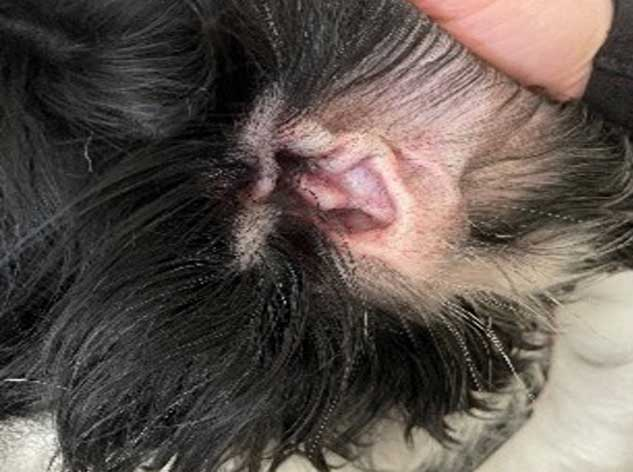
add
Mild erythema of the canine external ear
Typical clinical findings:
Mild redness of the skin in the ear canal and pinna with little to no discharge.
Typical cytological findings:
Keratinocytes (squames) present, sometimes but rarely with inflammatory cells but no evidence of microbial overgrowth. (Typically seen with atopic dermatitis and indicates inflammation without infection).
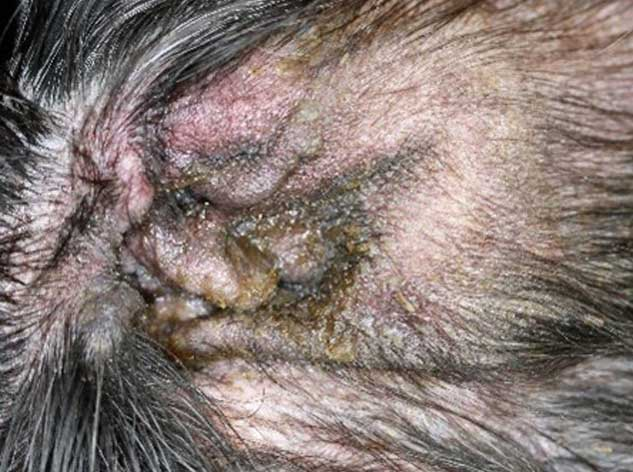
add
Moderate erythema of the canine external ear with think, brown or yellow-brown discharge (Credit CWalker, ThePhotoVet)
Typical clinical findings:
Moderate redness of the skin in the ear canal and pinna and a mainly waxy discharge.
Typical cytological findings:
Presence of inflammatory cells and overgrowth of commensals (Staphylococci and/or Malassezia).
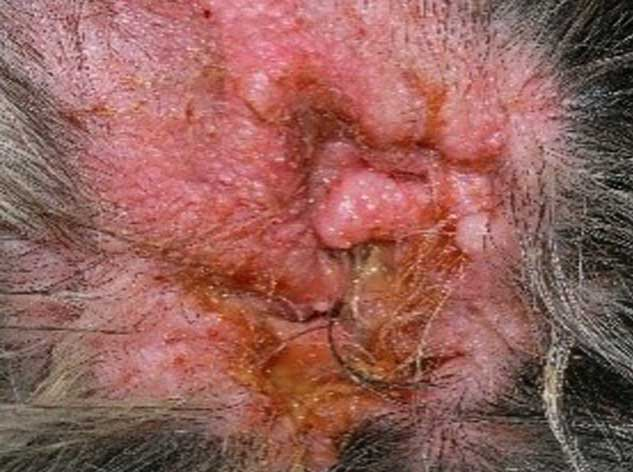
add
Severe erythema and possible ulcerations of the canine external ear with purulent exudate (Credit CWalker, ThePhotoVet)
Typical clinical findings:
Ear canal and pinna are often red, sometimes ulcerated and painful. Commonly associated with chronic disease and irreversible anatomical changes.
Typical cytological findings:
Extensive amount of inflammatory cells with possible rod shaped bacteria.
What are the most common primary causes of otitis?
Otitis externa often has a multifactorial aetiology, which can be divided into primary and secondary causes, alongside predisposing and perpetuating factors:
- Primary causes are factors which trigger initial inflammation in the ear
- Secondary causes are the infections which occur as a result of the primary inflammation
- Predisposing factors are the features which contribute to development of otitis externa, but would not cause disease alone
- Perpetuating factors are elements which prevent complete resolution of disease, even where other factors are addressed and treated
When thinking specifically about the primary causes of inflammation, it is important to remember that as the ear canal is lined with skin, any disease which affects the skin can also impact upon the ear.
Allergy, has been determined as the most common primary cause of OE5,6 in the dog. Behind this, foreign bodies (commonly grass seeds), parasites (Otodectes cynotis and Demodex spp) and underlying endocrine disease (hypothyroidism and hypercortisolism) have also been documented as more common primary triggers of inflammation leading to otitis externa5,6.
Allergic skin disease
As mentioned above atopic dermatitis (AD), is highly likely to be the trigger for primary inflammation in the majority of cases of otitis externa. In fact, OE has been reported as the first presenting sign in over 40% of dogs with AD7, and for some dogs, it is the only clinical sign they display. Alongside atopic dermatitis, adverse food reaction should also be considered as an allergic cause for OE5,6.
Regardless of the type of underlying allergy, the initial clinical and cytological picture is usually that of the erythematous otitis described above. It is only as the local environment changes as a result of inflammation and barrier function becomes compromised, that commensal organisms begin to overgrow leading to a secondary bacterial and/or fungal infection (typically Malassezia and Staphylococcus spp.).
Credit C Walker, ThePhotoVet

Why is it important to insist on revisits?
Most cases of otitis have a primary cause that needs to be identified and properly managed in a timely manner to avoid perpetuating, irreversible, chronic changes.
A revisit where you focus on checking the resolution of the acute inflammatory condition by discussing treatment compliance and repeating examinations is advised to ensure remission, but it is also important to start building a Lifelong Ear Partnership.
By working together as a team, and emphasising clear communication, you increase your chances of getting to terms with finding a long-lasting solution that works for all parties. The revisit is the key initiator of this process.
Lifelong Ear Partnership Owner Site
Our dedicated owner website includes video content to help communicate this important message with owners and help you kickstart your own Lifelong Ear Partnerships.
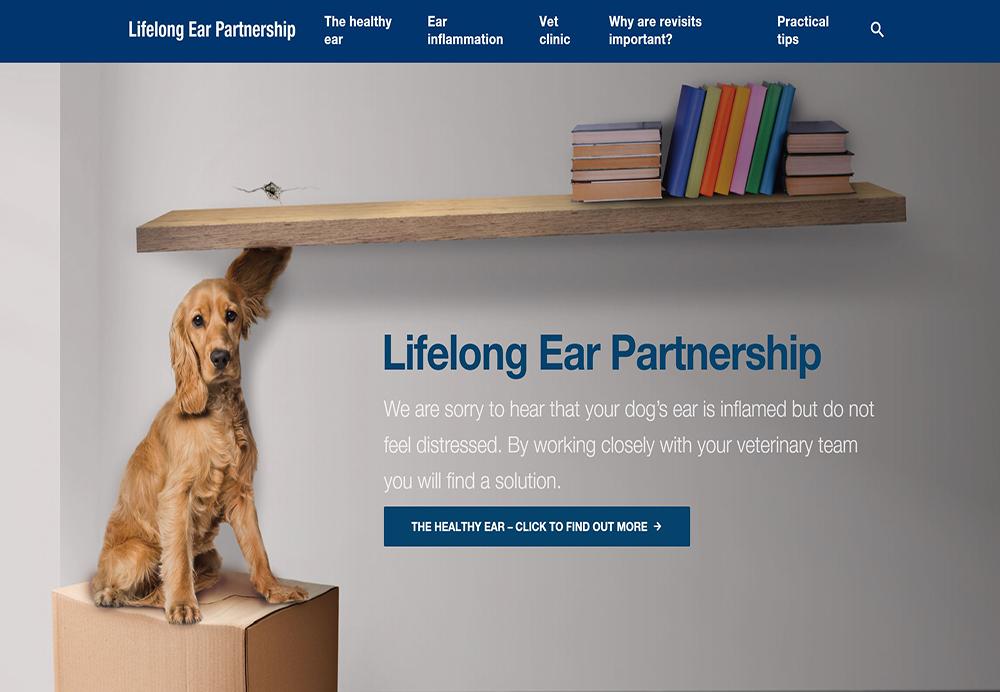
Why is cytology an important part of case management?
Cytology is important in all cases of canine otitis externa. Not only does it provide valuable information about possible overgrowth of microbes to evaluate if antimicrobial therapy is advised or not. It is also an important tool to assess treatment response and whether or not any change in strategy is needed.
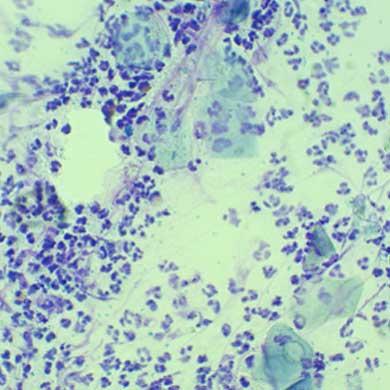
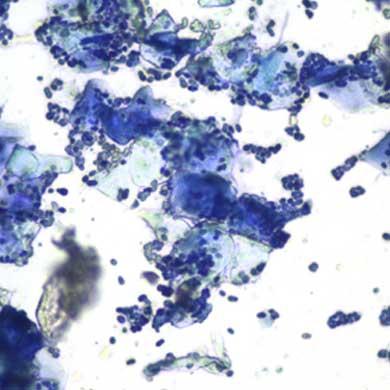
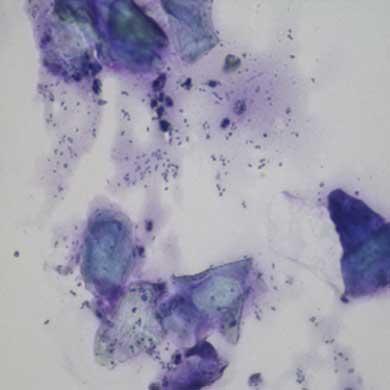
How do you choose treatment?
When it comes to the possible treatment options for both inflammation and infection of the ear, you will be aware that there are many different products to choose from.
The reason for the wide choice is that when it comes to otitis – there is no one solution which is best for every dog.
Every dog has a different experience with ear inflammation. This affects the visit to the vet but it can also mean that the dog is reluctant to allow the application of medicine.
If the medication cannot be applied properly, not only will the outcome be impacted but also the risk of antimicrobial resistance is increased.
To find out more about the solutions Dechra provides for otitis externa, veterinary professionals can click here.

Ear cleaners

Canaural®

Recicort®

Osurnia®
Summary of key points
- Otitis externa is one of the most common reasons why dogs present to general veterinary practitioners1.
- The PSPP system should be considered by all vets when managing a case of OE – this includes consideration of the primary cause, the secondary infection, the predisposing and perpetuating factors.
- Allergic dermatitis (including atopic dermatitis and adverse food reaction) is the most common primary cause of OE5,6.
- Cytology is a key component in both the diagnosis and long-term management of OE, and should be considered, alongside many other individual factors, when deciding upon the best treatment plan for a patient.
- Dechra advocate the formation of Lifelong Ear Partnerships with owners and patients with otitis externa, and provide a wealth of support for this.
Authors
By Emily Armstrong BVSc MRCVS
Veterinary Technical Manager
Dechra Veterinary Products

By Linda Holm Segerqvist DVM
European Companion Animal Product Manager – Otitis
Dechra Veterinary Products

References add

